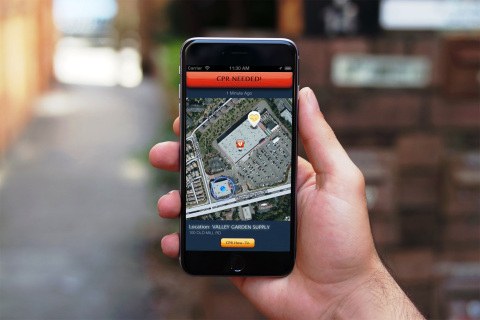REDMOND, Wash.--(BUSINESS WIRE)--For the first time, CPR guidelines issued by the American Heart Association (AHA) recommend that communities consider using social media and mobile app technology to alert CPR responders when someone nearby suffers sudden cardiac arrest. The new guidelines cite studies that show emerging mobile technologies can result in a “higher rate of bystander-initiated CPR.”
The leading bystander response mobile application, PulsePoint Respond, alerts users when a sudden cardiac arrest occurs in a nearby public place, directs them to the patient location and provides CPR guidance while paramedic units are en route to the call. The app also notifies users of the closest available Automated External Defibrillator (AED).
To date, the PulsePoint app has been downloaded more than 505,000 times and has alerted more than 16,500 responders to the need for CPR in more than 6,500 suspected sudden cardiac arrest incidents. PulsePoint is now active in more than 1,200 communities in 24 U.S. states and Canadian provinces.
The PulsePoint app has played a key role in saving several lives. The first documented PulsePoint save involved a 57-year-old truck driver near Portland, Oregon, who suffered sudden cardiac arrest outside his gym and received CPR from a PulsePoint responder. In Spokane, Washington, a five-week-old infant received CPR from a nearby off-duty EMS volunteer working at his job as a mechanic. In Sunnyvale, California, a 63-year-old father of two collapsed on a soccer field and received CPR from a college student living nearby who received a PulsePoint alert on his mobile phone.
“PulsePoint-connected communities don’t need to rely on the luck of having a CPR-trained citizen witness a cardiac arrest,” said Richard Price, President of the PulsePoint Foundation. “By directly notifying those who are qualified and nearby, PulsePoint helps put the right people in the right place at the right time. PulsePoint builds on the good work that a community has done with CPR training and AED placement and improves the efficiency and use of these resources. Two-thirds of our 24-hour healthcare professionals - firefighters, paramedics, police officers, nurses, doctors - are off-duty at any one time. With PulsePoint, responders like these are available to assist if they are made aware of an urgent need nearby.”
The PulsePoint apps were created by and are a product of the PulsePoint Foundation. Physio-Control is the foundation’s implementation partner and provides services to integrate PulsePoint with public safety agency dispatch and communication systems.
“Apps like PulsePoint can help save lives,” said Brian Webster, President and CEO of Physio-Control. “This new AHA guidance is a strong call to action. Quick bystander response to sudden cardiac arrests – performing early CPR and finding and using an AED – is a vital part of an effective system of care. Mobile devices are already in millions of hands – PulsePoint Respond puts lifesaving skills and awareness into those hands.”
“The PulsePoint mobile device system, for the first time, changes the old paradigm of waiting for trained EMS responders to arrive on scene,” said Dr. Bentley Bobrow, Medical Director, Bureau of Emergency Medicine and Trauma Services, Arizona Department of Health and past Chair of the American Heart Association Basic Life Support Subcommittee. “PulsePoint allows communities to harness the enormous life-saving potential of their citizens, many of whom are ready and willing to perform CPR and use an AED in the most critical minutes before trained EMS providers can arrive.”
Information on how to download the free PulsePoint app is available at this site. Public safety agencies interested in becoming PulsePoint-connected can learn more here.
About Sudden Cardiac Arrest (SCA)
Sudden Cardiac Arrest is the abrupt loss of heart function in a person who may or may not have diagnosed heart disease. Death can occur shortly after symptoms appear without rapid intervention and treatment. Each year, more than 420,000 emergency medical services-assessed out-of-hospital cardiac arrests occur in the United States. The American Heart Association states that “there is clear and consistent evidence of improved survival from sudden cardiac arrest when a bystander performs CPR and rapidly uses an AED.”
About the PulsePoint Foundation
PulsePoint is a 501(c)(3) non-profit foundation based in the San Francisco Bay Area. Through the use of location-aware mobile devices PulsePoint is building applications that work with local public safety agencies to improve communications with citizens, empowering them to help reduce the millions of annual deaths from sudden cardiac arrest (SCA). Deployment of the PulsePoint app can significantly strengthen the “chain of survival” by improving bystander response to cardiac arrest victims and increasing the chance that lifesaving steps will be taken prior to the arrival of emergency medical services (EMS). PulsePoint is supported by the Wireless Foundation, built and maintained by volunteer engineers at Workday and distributed by our marketing and implementation partner Physio-Control, Inc. Learn more at www.pulsepoint.org or join the conversation at Facebook and Twitter. The free app is available for download on iTunesand Google Play.
About Physio-Control
Physio-Control, Inc. is headquartered in Redmond, Washington. The company was founded in 1955 and is the world’s leading provider of professional emergency medical response solutions that predict or intervene in life-threatening emergencies. The company’s products include LIFEPAK® monitor/defibrillators and automated external defibrillators, the LIFENET® System, HealthEMS® electronic patient care reporting (ePCR) software, LUCAS® 2 Chest Compression System, TrueCPR™ coaching device, McGrath® MAC EMS video laryngoscope and implementation for PulsePoint mobile bystander response applications. Learn more at www.physio-control.com, or connect on Facebook, LinkedIn or Twitter.






.jpg)